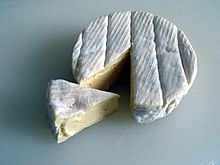White mold cheese

White mold cheese is a mold cheese in the production of which noble molds ( fungal cultures of Penicillium candidum or Penicillium camemberti ) are used. Usually the spores ( conidia ) of these mushrooms are added to the milk; the culture is more rarely sprayed onto the young cheese, which leads to an irregular distribution of the spores. The conidia concentration must show two million germinable spores on one liter of milk so that the risk of infestation with foreign mold is excluded.
After the cheese has been salted and the whey has dripped off , the ripening process begins. The temperature should be between 12 and 18 degrees Celsius. During the first 48–72 hours, yeasts appear primarily on the surface of the cheese. The spores of the noble mold ideally germinate before salting, but the colonies only become visible on the third day of ripening. After that, it won't be long before a dense mushroom lawn covers the whole cheese.
The color of the growth in young, mature cheese is pure white in the white Camembert mold Penicillium candidum and slightly bluish in the blue Camembert mold Penicillium camemberti , which is due to the different color of the spores of the two types of fungus.
The mushrooms provide the taste of the cheese, they give a fresh aroma that is reminiscent of the smell of mushrooms . The aroma and taste of a cheese also depend on the milk used, so there are white mold cheeses made from cow's milk as well as those made from the milk of sheep and goats .
Representatives of white mold cheese are camembert , brie , ermine and coulommiers . Some sour milk cheeses are also made using white mold.